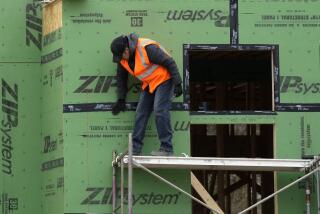Jobless Rate Reaches 8.1% in S.D. County
- Share via
SAN DIEGO — Unemployment reached 8.1% in San Diego County in June, the highest joblessness rate in nine years and further evidence that, after two years, the local economy is still mired in a recession.
Observers doubt that a recovery will come to the San Diego jobs market anytime soon. In fact, they said Friday that unemployment may increase as the local economy absorbs brunt of defense budget cuts and industry consolidations.
“This is probably among the worst economic situations San Diego has seen in 30 years,” said Max Schetter, director of research for the Greater San Diego Chamber of Commerce, adding that he was “pessimistic for the short-term outlook for a significant recovery in San Diego County.”
The higher local unemployment rate reflects the continuing erosion of San Diego County’s jobs base. Total wage and salaried jobs as of June were 956,400, a loss of 25,400 jobs since June, 1991, and 44,000 less than the record 1,000,500 jobs in December, 1990.
Observers expect the jobs totals to fall further as the region absorbs continued defense-related jobs losses. General Dynamics Convair missiles operation, for example, is expected to cut 4,500 local jobs over the next 13 months. Those job losses will in turn cause ripple effects among General Dynamics’ 600 local suppliers and subcontractors.
Among economists, there was little optimism that the employment decline will reverse itself soon. David G. Hensley, director of the UCLA Business Forecasting Project, said San Diego in particular and the statewide economy as a whole are still “declining” based on key economic indicators such as housing starts, auto sales, construction employment and retail sales.
“We were forecasting an economic rebound the end of this year, but it looks like we’ll have to push this back and that we may not rebound until spring of 1993,” Hensley said.
The San Diego unemployment rate is still lower than the state’s, which reached 9.5% in June, up from 8.0% in June, 1991. But San Diego’s joblessness was higher than the U.S. rate, which climbed to 7.8% in June, up from 6.9% in June, 1991.
Schetter said the loss of jobs “indicates the depth of the recession that we’ve been in. But what it doesn’t reflect is that a large number of the unemployed are in the mid- to higher level paying manufacturing positions.”
In addition to defense-related manufacturing, construction and retailing were among the hard-hit employment sectors over the past year, reflecting the depressed state of those two industries.
Unit sales of new houses and condominiums over the quarter ended June 30 were down 29% from the previous year. Retail sales over the first quarter of 1992, the latest statistics available, were up 5% only because the year-ago period was severely depressed by the Persian Gulf War.
As a result, retailing and wholesale trade jobs have shrunk by 8,000, and construction jobs are down by 5,100 over the past year, according to figures supplied by the state Employment Development Department.
Raford Boddy, professor of economics and coordinator of San Diego State University’s Center for Public Economics Forecasting Project, said San Diego’s current economic problems resemble those of the two-year recession beginning in 1973 when local unemployment topped 10%. Then, as now, a downturn in the business cycle coincided with deep military budget cuts, a double whammy for San Diego’s defense-reliant economy.
The June unemployment rate of 8.1% was the highest since July, 1983, when 8% of the work force was unemployed. The rate, which compares with the 7.0% rate in June, 1991, jumped a full point from 7.1% in May, partly because a wave of students entered the summer jobs market.
San Diego County has lost 4.5% of its jobs over the past two years. California has lost 600,000 jobs since 1990. Hensley said 175,000 of those lost jobs were in construction, and 90,000 were in aerospace.
More to Read
Inside the business of entertainment
The Wide Shot brings you news, analysis and insights on everything from streaming wars to production — and what it all means for the future.
You may occasionally receive promotional content from the Los Angeles Times.










